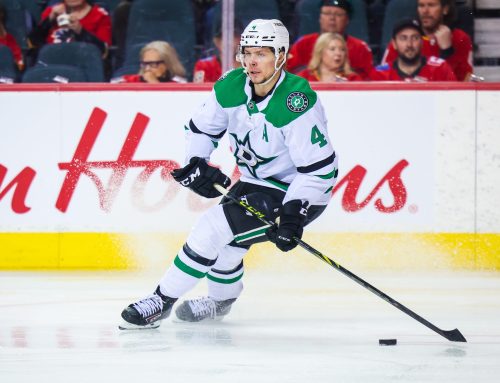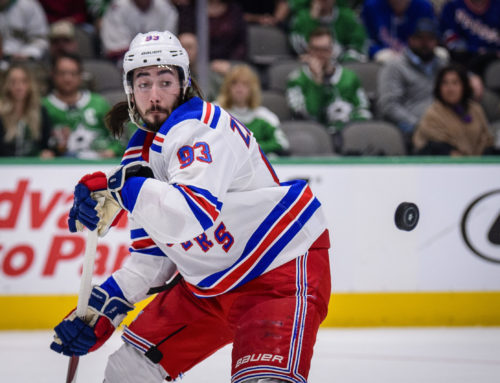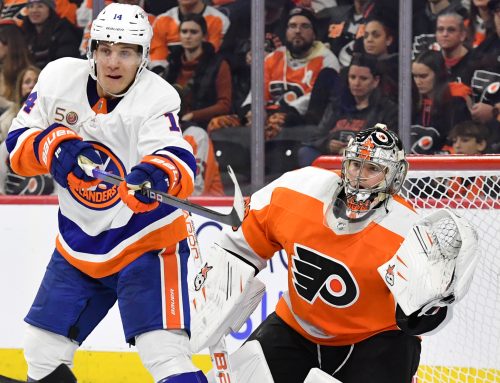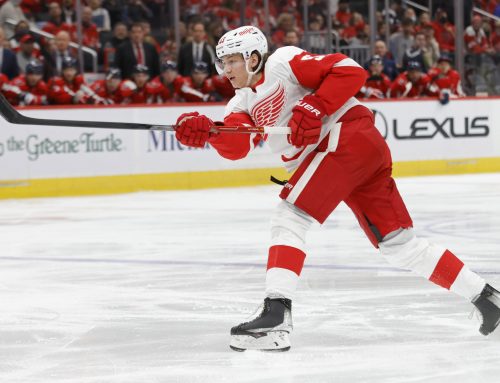Cage Match: Josh Bailey vs. Evgeny Dadonov
Rick Roos
2018-05-30

Two years ago isn’t a long time in the grand scheme of things; but in fantasy, it can be an eternity. Back in May 2016 one of our combatants (Josh Bailey) was a former top ten draft pick who, after 557 career NHL games, had yet to post more than 41 points in a season, while his opponent (Evgeny Dadonov) had last played in the NHL four years earlier and seemed like a lock to stay overseas. Fast forward to now, and Bailey just posted 71 points in 76 contests and Dadonov, upon returning to the NHL, tallied 65 in 74 games. Can we bank on both being top fantasy producers in future seasons, and which one should outperform the other? Let’s find out – Cage Match starts now!
Career Path and Contract Status
Bailey, 28, was drafted 9th overall in 2008 and stuck with the Islanders that season and next, posting 60 points in 141 games. In 2010-11 Bailey emerged with six points in five games, but then went scoreless in his next 13 contests, and then found himself in the AHL. There he posted 17 points in 11 games to earn a ticket back to New York, this time for good. Yet only once in the next four seasons did Bailey even manage more than a point per every other game, causing pretty much all poolies to label him as a fantasy bust. But then a funny thing happened – Bailey rose to 56 points in 2016-17, although 36 of those 56 points came in his first 27 games. Then before we could write off that season as merely two months of catching lightning in a bottle, he rose all the way to 71 points for 2017-18, although yet again he started much stronger than he finished, with 50 points in his first 39 games then only 21 in his final 37 contests.
Dadonov, 29, was picked 71st overall a year earlier than Bailey, and came stateside for 2009-10. What followed were three seasons of a combined 79 AHL games (posting 44 points) versus only 55 total NHL games, tallying a meager 20 points and culminating in his rights being traded to Carolina. Dadonov played overseas the next five seasons, during which his rights to Carolina expired, leaving him free to sign with any NHL team. After 66 points in 53 KHL games in 2016-17, that’s exactly what he did, ironically returning to the very same team which gave up on him during his first NHL run – the Panthers. Dadonov showed no NHL rust this past season, posting 65 points in 74 games, both starting (14 points in 11 games) and ending (20 points in 22 games) red hot, and all the while showing excellent chemistry with star center Aleksander Barkov.
Bailey avoided becoming a free agent this summer by inking a six year, $30M contract in February, while Dadonov is set to earn $4.0M per season through 2019-20 before becoming a UFA.
Ice Time
|
Season |
Total Ice Time per game (rank among team’s forwards) |
PP Ice Time per game (rank among team’s forwards) |
SH Ice Time per game (rank among team’s forwards) |
|
2017-18 |
17:53 (J.B.) – 2nd 18:42 (E.D.) – 4th |
3:01 (J.B.) – 4th 3:19 (E.D.) – 4th |
0:16 (J.B.) – 12th 0:00 (E.D.) |
|
2016-17 |
18:22 (J.B.) – 2nd |
2:50 (J.B.) – 2nd |
0:26 (J.B.) – 9th |
|
2015-16 |
15:51 (J.B.) – 4th |
1:26 (J.B.) – 7th |
0:31 (J.B.) – 5th |
|
2015-16 |
16:47 (J.B.) – 3rd |
1:39 (J.B.) – 7th |
0:10 (J.B.) – 8th |
Bailey’s data was somewhat surprising, at least to me. For one, he was receiving decent ice times in the two seasons before he broke out; however, of potentially more interest is that he dropped 30 seconds of ice time per game from 2016-17 to 2017-18 even as his scoring shot up dramatically. But a closer look reveals a third of that lost time was in the form of shorthanded duty, and another third was due to him logging only 2:52 in a game where he left injured. But none of this changes the fact that of the 70 instances of 75+ point scoring by a forward in the past five seasons, only one (Jonathan Marchessault this past season) was by a player with fewer total minutes in more total games, so Bailey’s 76 point scoring pace for 2017-18 is inherently suspect.
Still, Bailey now earning $6M per season bodes well for his ice time increasing. Yet where concern arises nevertheless is if John Tavares leaves as a UFA, since Bailey’s upped scoring over the past two seasons has come from being stapled to Tavares. But a deeper dive shows although Bailey played only about 10% of his 2017-18 ES shifts with Mathew Barzal on the ice but not John Tavares, those shifts resulted in 15% (i.e., six of 40) of Bailey’s even strength points. Thus, if Tavares opts to leave Long Island and Bailey gets paired with Barzal, the results could be better than some might otherwise predict.
As for Dadonov, with only one season of data there’s not much to go on. What we do know is he really clicked with Barkov, to the tune of only seven of Dadonov’s 65 points coming with Barkov not also on the ice. The good news is the team recognized that once they broke up their super line of Barkov, Dadonov and Jonathan Huberdeau, they kept Dadonov and Barkov as a pair. Chances are that should be no different for 2018-19.
Where concern arises, however, is last season was the first in which Barkov played in more than 71 games, and came after him missing 20 and 16 in his prior two seasons. If Barkov has not overcome his Band-Aid Boy ways and goes back to missing 10+ games per campaign, one would think that could put a damper on Dadonov’s scoring. Then again, of the three total games Barkov missed in 2017-18, Dadonov was hurt for one (December 9) but had two points in the other two (the last two of the season), so perhaps this is a red herring of a concern.
Secondary Categories
|
Season |
PIMs (per game) |
Hits (per game) |
Blocked Shots (per game) |
Shots (per game) |
PP Points (per game) |
|
0.22 (J.B.) 0.11 (E.D.) |
0.16 (J.B.) 0.36 (E.D.) |
0.42 (J.B.) 0.44 (E.D.) |
2.00 (J.B.) 2.54 (E.D.) |
0.41 (J.B.) 0.17 (E.D.) |
|
|
2016-17 |
0.14 (J.B.) |
0.45 (J.B.) |
0.64 (J.B.) |
2.11 (J.B.) |
0.14 (J.B.) |
|
2015-16
📢 advertisement:
|
0.27 (J.B.) |
0.55 (J.B.) |
0.31 (J.B.) |
1.29 (J.B.) |
0.06 (J.B.) |
|
2014-15 |
0.17 (J.B.) |
0.94 (J.B.) |
0.51 (J.B.) |
2.00 (J.B.) |
0.05 (J.B.) |
All eyes are immediately drawn to Bailey’s PPPt rate, which was stratospheric not just in general but also when compared to any past season. And with his power-play time and status on PP1 essentially unchanged from 2016-17, the reflex would be to see this number as wholly unsustainable. But is that indeed the case?
Digging deeper, the Isles went from 35 PPGs in 2016-17 to 58 in 2017-18, for a 65% gain. Yet that means Bailey got a PPPt on 34% of the team’s PPGs in 2016-17 and 53% this past season. So yes – Bailey has disproportionately (and, in turn, likely unsustainably) seen an increase in terms of PP scoring, and as such that could cut against him being a repeat member of the 70+ point club, particularly since he’s also not a prolific shooter and, as noted above, has not yet received a lot of minutes. Then again, getting 53+ assists and 31+ PPPts without posting 80 points puts him in a club with only 12 other forwards since 2000-01; and of those 12, only two never managed an 80+ point season. However, all but one of the 12 either had their 53+ assist 31+ PPPt season at a younger age than Bailey as a stepping stone to greater things, or did so while older than Bailey and never had another as productive season. Thus, while past results do not represent predictive data, these comparisons are not especially encouraging.
On the other hand, Dadonov’s numbers seem reasonable but also capable of improvement, as he shot the puck a good amount and had a PPPt rate that was decent but could realistically see gains. Dadonov also was the slightly better of the two in PIM, hits, and blocks, although both are below average multicat contributors overall. The strange thing is as recently as three seasons ago Bailey was rock solid in hits; however, after shedding them each of the last three seasons he’s now a legitimate drag in the category and is unlikely to go back to his former ways given his new style of play and emphasis on scoring.
Luck-Based Metrics
|
Season |
Personal Shooting % |
Team Shooting % (5×5) |
Individual Points % (IPP) |
Offensive Zone Starting % (5×5) |
Average Shot Distance |
Secondary Assists % |
|
2017-18 |
12.0% (J.B.) 14.9% (E.D.) |
8.73% (J.B.) 9.83% (E.D.) |
74.0% (J.B.) 67.0% (E.D.) |
50.4% (J.B.) 43.6% (E.D.) |
30.3 (J.B.) 27.3 (E.D.) |
45% (J.B.) 35% (E.D.) |
|
2016-17 |
7.5% (J.B.) |
9.62% (J.B.) |
61.5% (J.B.) |
62.5% (J.B.) |
30.0 (J.B.) |
46% (J.B.) |
|
2015-16 |
11.4% (J.B.) |
7.49% (J.B.) |
61.5% (J.B.) |
50.0% (J.B.) |
25.8 (J.B.) |
30% (J.B.) |
|
2014-15 |
10.7% (J.B.) |
9.04% (J.B.) |
64.1% (J.B.) |
64.6% (J.B.) |
25.2 (J.B.) |
43% (J.B.) |
Once again the most glaring number belongs to Bailey, as his IPP jumped from a range of 61-64% over the past three seasons, to 74% in 2017-18. But before we leap to initial conclusions, Bailey’s IPP was 69% in 2013-14 and 73% in 2012-13, so this is not as uncharted territory as it may seem at first. But how should we react to it? I can see an argument to be made that it, on top of Bailey’s PPPt rate spiking, is a sign his 2017-18 production was unsustainable and we should be prepared for it to come back to earth with a crashing thud. Then again, with a 5×5 team shooting percentage that was reasonable, and his past dalliances with IPPs higher than 61-64%, perhaps this is not as unsustainable as it seems?
In addition to Bailey’s assists totals climbing for two straight seasons, we also see here that when he does shoot it’s from farther and farther away from the net with each passing season. So although Bailey was never a sniper to begin with, this seems to underscore the nature of his current game is that of a passer, not a goal scorer. One concern there is if indeed Tavares signs elsewhere and Bailey is paired with Barzal, what happens then, as Barzal is even more of a set-up man than Bailey? It might just be that the team would keep them apart at even strength, which likely would hurt Bailey’s production.
The numbers for Dadonov aren’t especially encouraging. While he managed to produce as well as he did despite such a low OZ%, a glass half empty argument would be that doing so was unsustainable good luck unlikely to be repeated, particularly in view of a less than 70% IPP and a team shooting percentage at 5×5 which was a good bit higher than the 9.0% normally seen from top six forwards. Even still – at worst these suggest a player who might find it difficult to see his point total rise and perhaps could shed maybe just a few points if luck smiles upon him a bit less next season.
Who Wins?
Before picking a winner, I’ll say this – I see both as cost vs. value players to avoid in one-year leagues for 2018-19. Dadonov’s ship seems tied to Barkov, who is yet to definitively show he’s no longer a Band-Aid Boy, plus Dadonov seemed to have had more than his fair share of good luck smile upon him last season. Meanwhile, Bailey’s PPPts were stratospheric, and his IPP, although not quite in uncharted territory, was high for him. Plus, it’s not clear that Tavares, with whom Bailey has shown great chemistry, will be back with New York next season. Given these caveats, plus their likely cost, I’d advise avoiding either player in one-year leagues, particularly multi-cats where we know their shortcomings (i.e., in penalty minutes, hits, and blocks) will be a negative factor.
Still though – there’s the task of picking a winner. I’m going to go with Dadonov, as the chemistry he and Barkov have is real; and unlike with Tavares, we know Barkov is staying put for at least as long as Dadonov will be in town. Plus, although Dadonov has even less of an NHL track record as Bailey, he did have KHL success and Bailey’s late career breakout – although not unprecedented – comes with a lot more potential concerns about regression.





 BUF
BUF N.J
N.J PHI
PHI MIN
MIN FLA
FLA WPG
WPG TOR
TOR CGY
CGY MTL
MTL